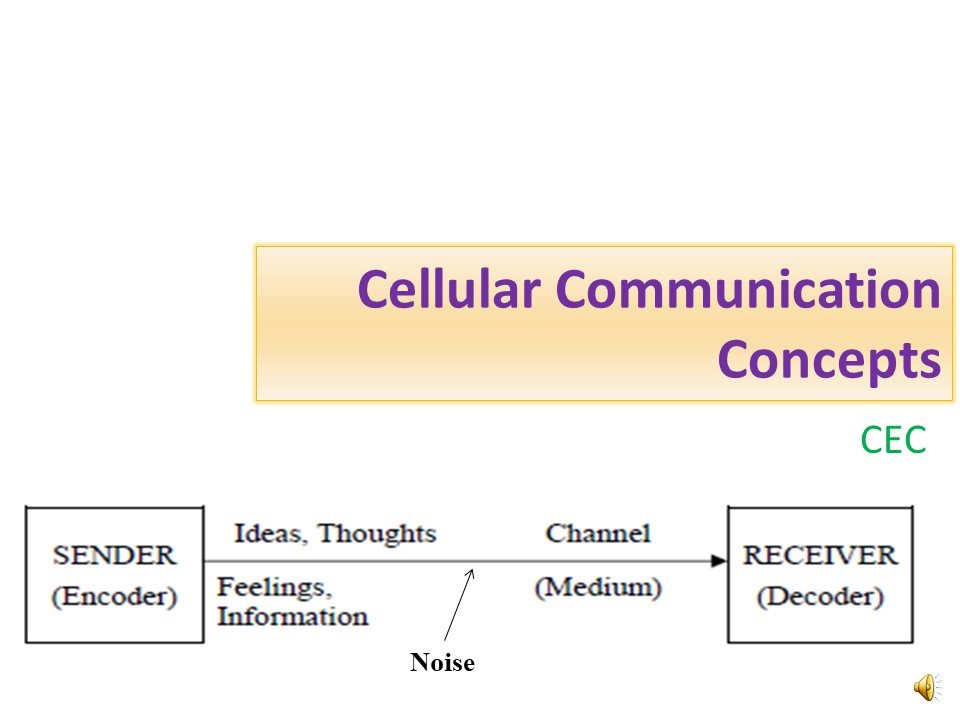Cellular Communication Concepts - PowerPoint PPT Presentation
Title:
Cellular Communication Concepts
Description:
The attached narrated power point presentation attempts to explain the basics of cellular communication and GSM Network. – PowerPoint PPT presentation
Number of Views:11
Title: Cellular Communication Concepts
1
Cellular Communication Concepts
- CEC
Noise
2
Contents
- Concept of Communication.
- Concept of a Cell.
- Frequency Reuse.
- Block Diagram Explanation.
- Hand Off.
- Roaming.
- Capacity Enhancement.
3
Concept of Communication
4
Concept of Communication
A ? B
A
Simplex or Duplex?
A ? B
B
5
Concept of a Cell
Cluster A group of cells.
6
Why Cellular Shape?
Spatial division into hexagonal cells, not
circles, Why cellular???
7
GSM Network
- GSM - Global System for Mobile Communications.
- Idea developed at Bell Laboratories in 1970.
- Open and digital cellular technology to transmit
voice and data. - Uses 850 MHz, 900 MHz, 1800 MHz and 1900 MHz
frequency bands. - Different cell sizes macro, micro, pico, and
umbrella. - Each cell has it own frequencies (10 50).
8
General Block Diagram
9
Cellular Communication
Two way Duplex!
10
Detailed Block Diagram
MS Mobile Station. BTS Base Transceiver
Station. BSC Base Station Controller. MSC
Mobile Switching Centre. VLR Visitor Location
Register. HLR Home Location Register. AUC
Authentication Centre. EIR Equipment Identity
Register.
11
Block Functions
- Mobile Station (MS) A station in the cellular
system intended for use while in motion, your
mobile phone. - Base Station (BTS and BSC) Fixed Station
consisting of radio channels and transceiving
antennas mounted on a tower located at the centre
or on the edge of a coverage region. - Mobile Switching Centre (MSC) Switching centre
connects base stations and mobiles to public
switched telephone network (PSTN), also called
Mobile Telephone Switching Office (MTSO).
12
Block Functions
- Mobile Switching Centre
- - responsible for routing voice calls and
SMS. - - sets up, releases end to end connection.
- - handles mobility, hand off requirements
- during the call.
- - real time prepaid account charging and
- monitoring.
13
Block Functions
- Gateway MSC
- - determines which visited MSC subscriber
- being called is currently located.
- - routes calls to PSTN/mobiles.
- . Anchor MSC MSC from which hand off has been
initiated. - . Target MSC MSC to which handoff should take
place.
14
Block Functions
- Equipment Identity Register (EIR) maintains an
account of all mobile equipments, each equipment
identified by International Mobile Equipment
Identity (IMEI) number. - Location Registers Home Location Register (HLR)
and Visitor Location Register (VLR) provides call
routing and roaming capabilities. - Authentication Centre (AUC) Identification and
verification of SIM validity, ensures subscriber
privacy by assigning a temporary mobile
subscriber identity.
15
Frequency Reuse
1
3
2
4
5
6
Reuse to conserve bandwidth. No channel reuse in
a cluster.
7
8
16
Frequency Reuse
- Communication within a cell at a given frequency.
- Same frequency for multiple conversations.
- Reuse of frequencies in non-adjacent cells.
- Minimum interference.
- Multiple frequencies per cell.
17
Capacity Enhancement
Congested cell into smaller cells.
18
Cell Splitting
- Subdividing a congested cell into smaller cells
with each smaller cell having its own base
station. - Can be permanent or dynamic splitting.
- Cells to microcells and smaller.
- Utilizes allocated frequency spectrum in real
time. - Increase system capacity.
- Useful for capacity enhancement.
19
Hand Off
20
Hand Off
Make after Break
Make before Break
21
Roaming
- A travelling cell phone to be connected to a
network without breaking the connection. - Ability to make and receive voice calls, send and
receive data or access other services when
travelling outside the geographical coverage area
of the home network. - Hop to another network if needed.
22
Conclusions
- Integration of voice and data.
- Global coverage.
- Wireless!!!, need for physical copper eliminated.
- 2G, 3G, 4G, 5G, 6G..?
- CDMA has become extinct.
- New features every generation..
23
References
- Aneesh P Thankachan, Basic Electronics
Engineering, PHOENIX Book Publishers, 2017. - Your standard reference text books
- Internet Sources.
24
Thank You































